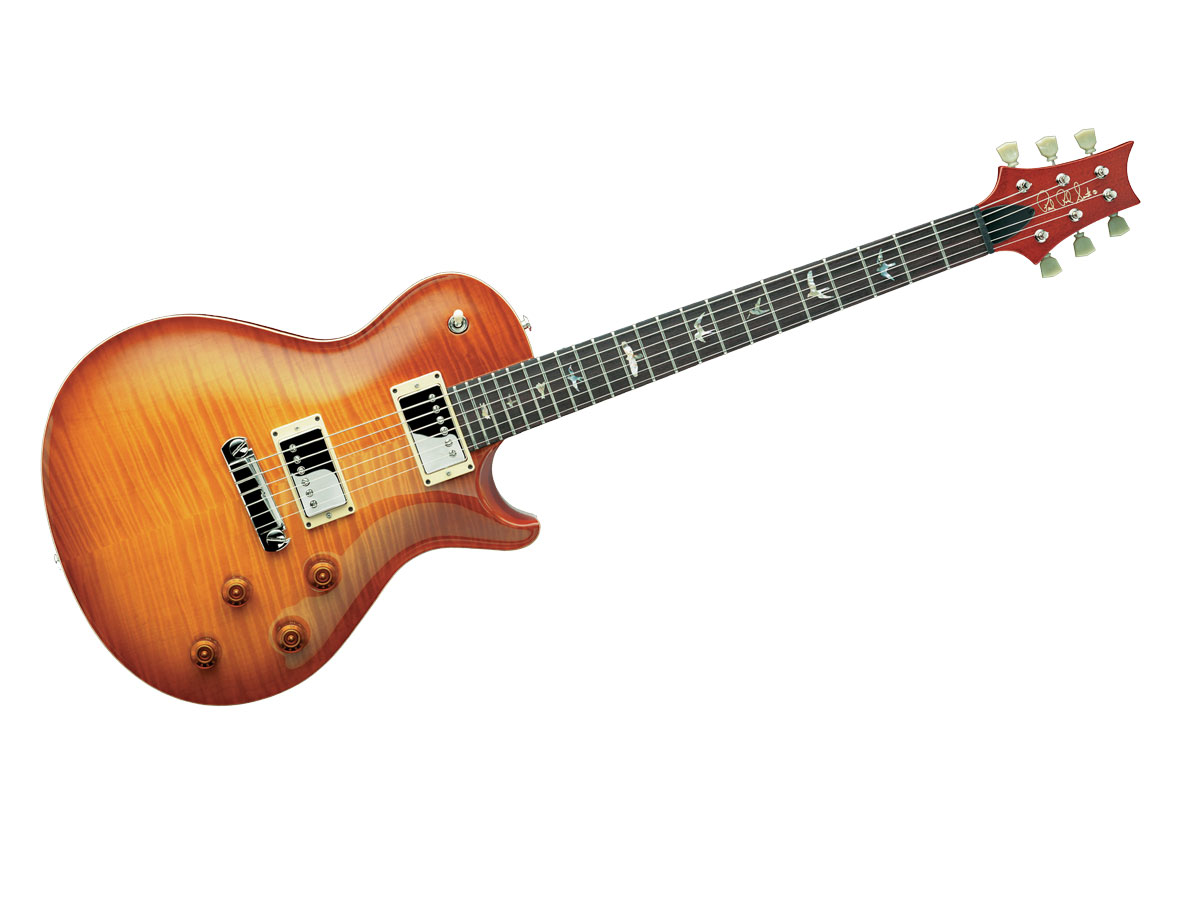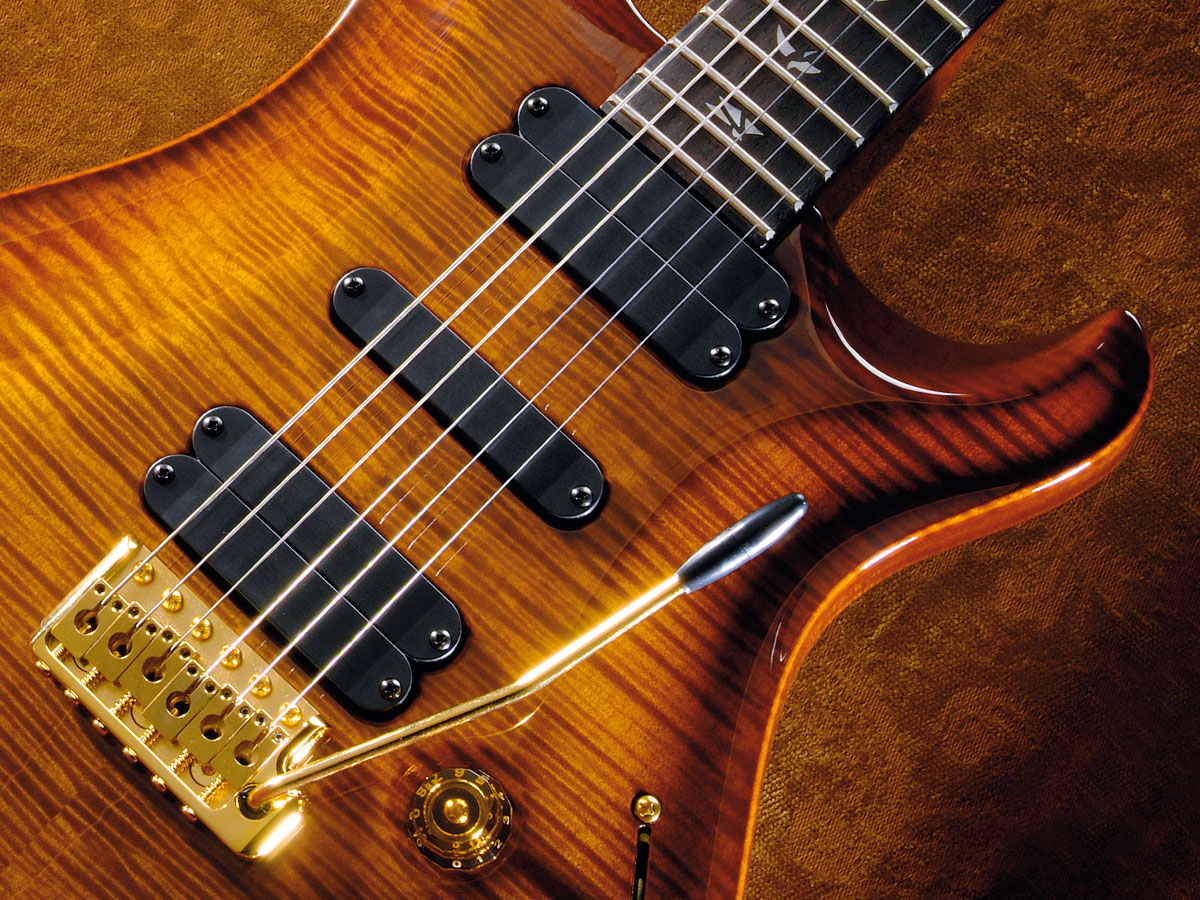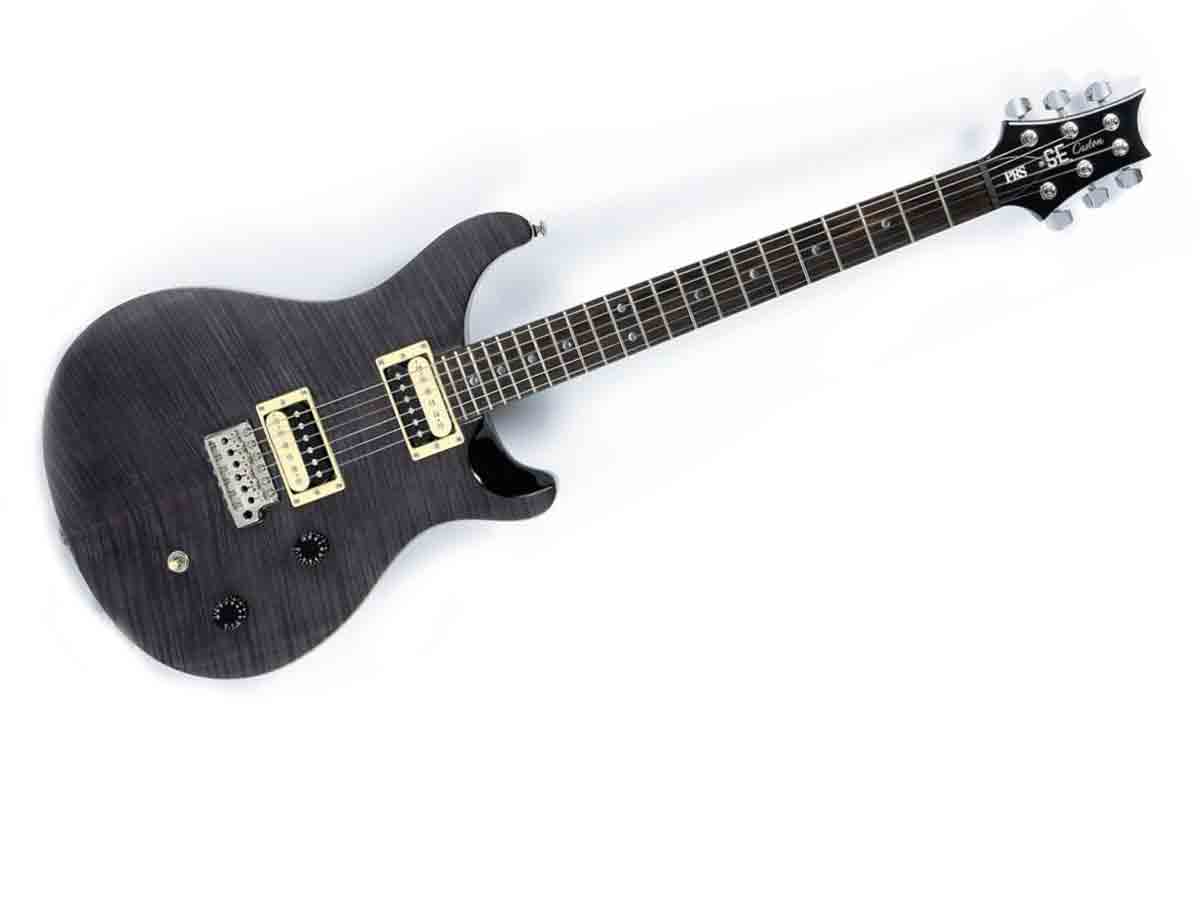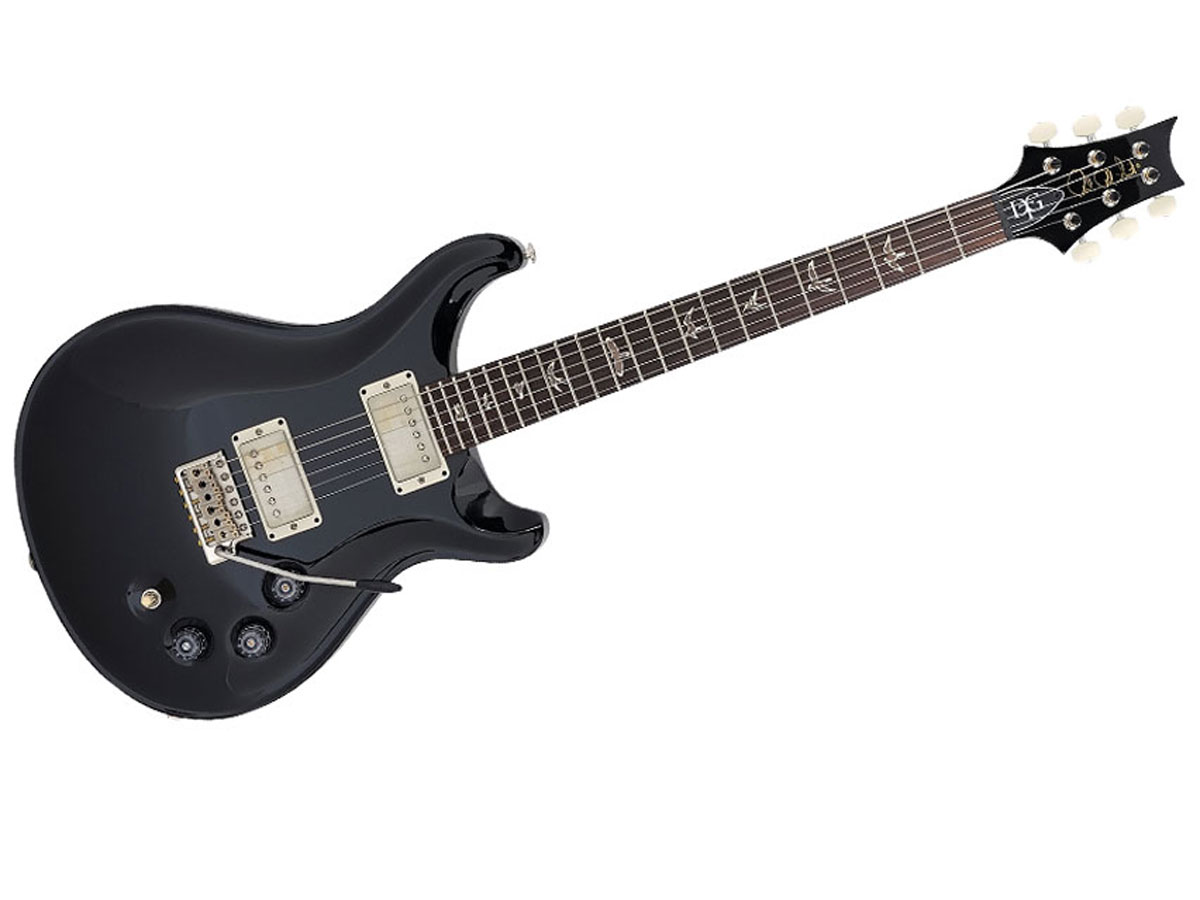30 years of PRS: 30 landmark guitars
From proto PRSs to modern masters

Paul's 1st guitar
We trace the history of PRS from before Paul Reed Smith opened his first factory to the present day. It’s been a ride…
- You'll find a wide range of PRS guitars at competitive prices at guitarsuperstore.co.uk
Paul’s 1st guitar
Although he’d made his first fretted instrument, a rather odd-shaped electric bass guitar, in 1972, Paul Reed Smith completed his first electric guitar on 20 May, 1975, aged 19, at St Mary’s College, Maryland. He earned four credits for the instrument and his college deemed it was “of professional quality”.
Frampton guitar
A year later, Paul Reed Smith completed a custom guitar for Peter Frampton; it was the first to feature what The Evening Capitol newspaper called “wildlife figures” running down the fingerboard. We, of course, know them as bird inlays.

Santana guitar and Custom
Santana guitar
Smith literally banged on backstage doors to show off his instruments: he managed to show the Frampton guitar to Carlos Santana after Al DiMeola had seen it and had ordered his own, a 12-string.
A couple of years later Santana did order one, modelled on the first maple-topped guitar Paul had built for Heart’s Howard Leese. It was completed in 1980, maple top No 3.
Custom
Smith’s huge-selling ‘hit single’ was written and refined into a finished article by the end of 1984.
The majority of the features we know today were all in place including the unique new body outline and headstock shape, the vibrato system with locking tuners and the dual humbuckers with single coil switching. Oh, and those bird inlays, of course…

Standard and Signature
Standard
When PRS starting producing factory-built guitars in 1985 - 10 years after Paul had hand-built his first proper electric guitar - they offered the maple topped Custom and the all-mahogany ‘PRS Guitar’ which didn’t become known as the Standard until 1987.
Aside from the all-mahogany body, it was the same guitar. The stripped ‘graphic’ finish Metal was short-lived. “We couldn’t give them away!” said Smith. Today, if you own one, you might find it’s worth a bob or two…
Signature
By ’87, PRS was certainly on the radar. It had also established a quality-led reputation and a price to match.
When a friend remarked, “you don’t charge enough,” Smith went upmarket further with the then ultimate-quality Signature, produced from 1987-91. The ‘posh’ PRS had arrived… along with the ‘doctors and dentists’ put-down, referring to the only people that could afford them.

Classic Electric and EG
Classic Electric
Along with the ‘too expensive’ reputation that has dogged PRS for 30years, its inability to produce a more affordable guitar in the USA (until 2014’s S2 range) has been another constant.
The Classic Electric was not only PRS’s first bolt-on but a nod in the direction of a more ‘Fender’ toned guitar with an alder body and maple neck. But Peavey object to the name, which was changed to ‘CE’, and the market said it wasn’t PRS enough and maple tops and rosewood fingerboards were swiftly added; by the mid-nineties the alder bodies were changed to mahogany.
“The CE was an accepted bolt-on guitar from us,” reflects Smith, “but it came to a point where they weren’t selling, so we stopped making 'em. People don’t look at us for making bolt-on guitars, but it doesn’t mean we’re not good at them. The Brent Mason is wonderful; I don’t like DC-3s… I love them!”
EG
First introduced in 1990, the EG - as in ‘Electric Guitar’ - lowered the price of the PRS even further as well as being the brand’s first 22-fret guitar and the first flat-front instrument.
Despite selling well in Europe, it wasn’t liked domestically and was swiftly updated (in ’92) by the more successful EG II - the first PRS to have body parts made outside of the factory on CNC machines, and the first lefty PRS.

Dragon and Custom 22
Dragon
Since his teens, Smith had dreamt of creating a guitar with a dragon inlay down the fingerboard. He actualised that in 1992 with the Dragon I, a 50-piece limited edition that cost $8,000!
Behind the inlaid fingerboard, however, lay a desire to improve the acoustic sound of the PRS guitar; it was the first 22-fret set-neck instrument and the first to feature the non-vibrato Stoptail bridge.
Custom 22
Aside from the 22-fret bolt-on EG, all PRS guitars had featured a longer 24-fret neck, until the Dragon I.
The ‘93 Custom 22, therefore, became the production version of the Dragon, also offered with the new Stoptail bridge and PRS’s biggest ‘wide fat’ neck profile. By the following year, all the PRS range had 22-fret options.

McCarty Model and Guitars of the Month
Mccarty Model
Theodore ‘Ted’ McCarty had been president of Gibson during its 1950-66 ‘golden era’, presiding over all the classic electric solidbodies and ES semis. But nearly three decades later he’d been all but forgotten.
Smith got to know Ted and he became a friend and mentor, famously “downloading the hard disk” on how Gibson made instruments and carried out its business back in the day.
But when PRS introduced the McCarty Model in ’94, Ted was back in the limelight: a clever piece of marketing (which didn’t go down well at Gibson, natch, especially when McCarty was pictured in an original advert) that reflected a more vintage-style PRS instrument: it featured a slightly deeper body, thinner headstock, lighter tuners and revoiced pickups.
Some of the McCarty’s features were already in place and some came from suggestions of Texas guitar slinger David Grissom, a long-time PRS player who was highly respected by Paul Reed Smith.
Cosmetically, the original McCarty typically used ‘red’ Michigan maple for its tops - the same kind that Gibson used in the fifties as opposed to the more striped, ‘curly’ West Coast maple more regularly used by PRS.
For the first time on a production PRS, the McCarty used a Gibson-style three-way toggle to switch the pickups that, again a first on a PRS guitar, reverted to original PAF-style covers. A pull/push switch was added a little later for coil-splits - this new set-up became known as the ‘McCarty electronics’.
“I didn’t contribute anything to the design,” said Ted McCarty at the time of its launch. “The PRS McCarty is his [Paul’s] design.” “The reason we called it the McCarty Model,” explained Paul Reed Smith, “is because everything Ted was teaching me is incorporated. He taught us how to make PAFs. Our Dragon Bass pickup is the result. So, yes, Ted did have a part in the design.”
Guitars of the Month
A high-end 12-guitar run of one-offs that were produced between late '94 and early ’96, the Guitars of the Month became the precursor to PRS’s Private Stock programme: a ‘custom shop’ making one-offs for customers and artists, prototypes and small runs of unique instruments. A masterstroke for those wanting the best and who could afford to pay for it.

Archtop and Hollowbody
One of the Guitars of the Month was PRS’s first f-holed hollow-body. Master luthier Joe Knaggs made two more in the new Private Stock programme. Describing himself as a keen “ex-jazz guitarist”, Knaggs was the architect behind the Archtop and the thinner-bodied Hollowbody, which both launched in 1998.
PRS had been using computer-assisted routing machines and design software since the mid-nineties and these modern tools helped create these innovative guitars, which were entirely hollow save for a block under the bridge that connected the top to the back and helped reduce feedback.
The backs were hollowed out from a large slab of mahogany and certain models were capped with a maple back, while tops were either spruce or maple-carved, like a violin, inside and out.
While both designs added depth to the PRS shape. the outline remained the same as the original Custom. Ultimately, it was the Hollowbody that caught on and with LR Baggs, PRS designed a (originally optional but now standard) piezo system, allowing players to add an acoustic-like sound to the more conventional magnetic Archtop humbuckers.
Nonetheless, even the Hollowbody was a bit of a sleeper. “David Grissom demo’d the Hollowbody for 10 years on our booth - 10 years! - and finally we started to sell them. That surprised me, our industry is very slow to move,” Smith said recently.

Singlecut
Fifteen years into PRS’s history and the company still had, primarily, one outline design augmented by the earlier ‘Santana’ shape (which didn’t become a PRS production guitar until 1995) and the EGs, which had been discontinued in ’95.
That changed in 2000 with the launch of the single-cutaway, Les Paul-inspired Singlecut. Famous legal action with you-know-who followed…

Santana SE
The Santana SE introduced the ‘Student Edition’ line, which debuted in 2001. Made in Korea, the SE finally solved the ‘affordable PRS’ quandary.
The highly successful and constantly evolving range, which includes numerous signature models alongside Carlos Santana, has put PRS’s style and quality into a completely different market.

513
Providing both single coil and humbucking tones on the same guitar was one of the Custom’s design keys, but in 2004 PRS introduced the 513 Rosewood with five single-coil pickups and a potential 13 sounds.
The more simple PRS 305 (as in three single-coil pickups and five sounds) followed in 2010.

20th Anniversary Dragon 6/12
Arguably the most outlandish PRS ever made, this very rare 6/12 double neck features two fighting dragons drawn by Jeff Easley and featuring 863 different inlay pieces.
Like previous Dragons, the inlay work was handled by Larry Sifel and his Pearlworks team… “with a lot of help from the Private Stock team,” said Joe Knaggs at the time.

SE Custom
There was always a resistance to mirroring the cosmetics of the USA models within the SE line. It wasn’t until 2005 that the first maple-topped Custom 22-fret appeared.
It used a proper maple top with a figured maple veneer facing to provide both the sound of the classic maple/mahogany body and the look of a highly expensive figured maple top but at a fraction of the cost.

Mira and SC245
Mira
Once again, the “affordable” PRS guitar entered the fray, this time made in the USA.
The all-mahogany 2008 Mira, designed primarily by Joe Knaggs, created a new body shape with bevelled contours - a nod to players who wanted a less-posh aesthetic. Along with the ’09 Starla, it laid the foundation for the S2 line.
SC245
Always popular with artists, the controversial Singlecut proved less popular with the general public.
One of the first changes was the 2007 SC245, which reduced the usual 25-inch scale length to 24.5-inches (closer to Gibson’s actual scale length of 24.6-inches).
This shorter scale is now used numerous Singlecuts including the current SC 245 and new P245 and numerous SE models - the 245, Zach Myers, Santana and Bernie Marsden.

David Grissom Tremolo (DGT)
2008 saw the introduction of many players’ favourite PRS, the DGT - finally a David Grissom signature, a result of his years of PRS playing.
It added a second volume control, new-design pickups, lighter ‘faux’ bone tuner buttons and Grissom’s own neck shape, and a nitrocellulose top-coat finish.

Paul's 28 and Sunburst series
“I went out on the floor and made guitars for the months of November and December [2008] so people could have christmas bonuses. It was fun; I enjoyed it. The pernambuco necks were new,” said Smith of this high-end, 28-only run.
“Everything we’d learnt up to that date, we did. But I had my hands on them. Guitars from my old ‘shop [pre 1985] are going for $40k, minimum, so it just made sense.”
Sunburst Series
This mini series of nitrocellulose-finished models - a Sunburst 22, Sunburst 245 and Smokeburst McCarty - were classed as “extremely vintage guitars” by Paul Reed Smith.
Among their details were new 1957/2008 (aka 57/08) covered humbuckers made using the same coil wire as Gibson had used back in the fifties. 59/09 and 53/10 'buckers followed, resulting in the latest 58/15 and uncovered 85/15 'buckers.

Amps
When PRS moved to its current home on Kent Island, Stevensville, the size of the facility seemed extraordinary; it was soon expanded to allow both amplifier and acoustic guitar production.
The late-noughties financial chaos put the brakes on that, but with amp specialist Doug Sewell onboard PRS has slowly gained a reputation for quality amps, not least with the most recent Archon series.

Acoustics
From launching with a big noise in '08 to becoming a mainstream acoustic guitar manufacturer, PRS acoustics have gone upmarket and carved a niche into the boutique market.
“We took a certain amount of money to create the acoustic line,” says Smith today, “and we were going to build up the line. But when it became evident that we could make the S2, we took all of that money and put it into that, not the acoustics.”

25th Anniversary
Battling a worldwide global financial crisis, PRS came out fighting in 2010 with more than 20 new models. There were 13 anniversary guitars and an Anniversary amp and acoustic.
The McCarty Model and the Special returned, the 513 Swamp Ash, Starla X and all-korina versions of the SE One and SE Singlecut were added. Limited-run models included the ‘Ted McCarty’ SC and DC 245, a special 1959/2009 run and the 100-only SE Santana Abraxas. From Private Stock came the ‘Violin Guitar’ and a 100-only 25th Anniversary Dragon. Phew!

JA-15 and Signature Ltd
JA-15
With a couple of exceptions PRS had largely ignored the hollow and semi-hollow markets since the launch of the Archtop and Hollowbody back in the late nineties.
The single-cut JA-15 hollow-body, a collaboration with Paul Jackson Jr, appeared in 2011, a year that brought a swathe of new features across the USA line: the hybrid V12 finish, new ‘pattern’ neck shapes, a two-piece bridge and new tuner design.
Read our full PRS JA-15 review
Signature Ltd
While implementing gradual and subtle changes in the way PRS guitars were made, as the 25th Anniversary passed Smith still aimed for the ‘ultimate’ pickup system.
A new design appeared first on the Private Stock Signature Ltd, then eventually on the 2013 408 that combined a smaller aperture neck pickup with a wider bridge pickup - both with ‘zero volume loss’ single coil switching.
This concept goes back to the ‘Sorcerer’s Apprentice’ guitar that pre-dated the Custom in the early eighties.

S2
Classed as “an engineering project” by CEO Jack Higginbotham, PRS finally cracked the ‘affordable’ USA-made dilemma with the S2, made at the USA factory but on a completely different and faster production line and using a combination of USA and offshore parts and pickups.
Launched in 2014 with three models - the S2 Custom, Starla and Mira - the range has expanded quickly to include semi-hollow models (Mira, Custom 22 and Singlecut) and the latest S2 all-mahogany-with-scratchplate Standards (22, 24 and Singlecut): a new guitar is promised for early in 2015, the third in the Mira/Starla lineage.
But aside from being approximately three-fifths of the cost of the now-called ‘core’ USA models, S2 is aimed at a different customer.
“I’ve come across people that frankly hate what we do,” says PRS’s Jim Cullen, one of the leaders of the S2 charge.
“I’ve heard this of our core guitars: people love the neck shapes, they know they stay in tune, it’s a great tool but they don’t want to hang a piece of furniture around their necks. A guitar is a fashion statement to many people. A Rickenbacker might be a bit of a weird instrument but it looks awesome!”
“I’d play an S2 any day,” states Paul Reed Smith today. “An all-mahogany Standard, I’d play one of those. It sits well on the strap; it plays really well. If I want a curly maple top I’d want a Private Stock grade. So yeah, I’d play a mahogany S2 any day.” So back to where you started? “Yeah!”

Brent Mason
Sessioneer to the stars not to mention country legend, Brent Mason is the latest PRS signature artist but his choice of guitar is rather unusual, based on the korina-bodied NF-3 with its bolt-on maple neck.
The pickup system is inspired by the 408 and it’s one of the most versatile bolt-ons we’ve ever played. Rumour has it PRS are continuing to develop a ‘three single coil’ guitar? “I’m not answering that,” replies Smith.
Read our full PRS Brent Mason Signature review
- You'll find a wide range of PRS guitars at competitive prices at guitarsuperstore.co.uk
Dave Burrluck is one of the world’s most experienced guitar journalists, who started writing back in the '80s for International Musician and Recording World, co-founded The Guitar Magazine and has been the Gear Reviews Editor of Guitarist magazine for the past two decades. Along the way, Dave has been the sole author of The PRS Guitar Book and The Player's Guide to Guitar Maintenance as well as contributing to numerous other books on the electric guitar. Dave is an active gigging and recording musician and still finds time to make, repair and mod guitars, not least for Guitarist’s The Mod Squad.


